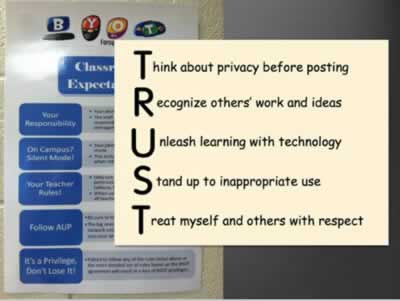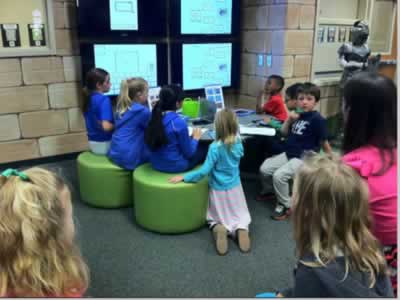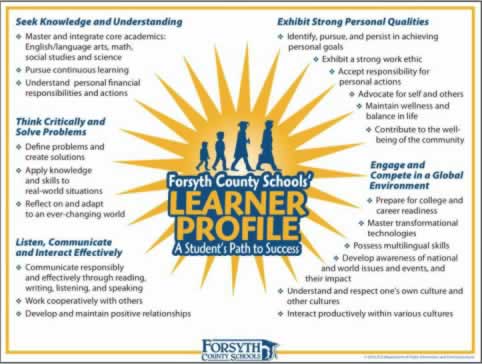What every school district needs to know–outside of devices–that will make BYOD implementation a success
 By now, most districts considering the implementation of BYOD know there’s a lot more to success than apps and devices. But how can districts accurately measure how much bandwidth is needed? How do you ensure the quality of student work outside of simply using an app? And can you truly ensure equity? According to one school district, there are hidden gems of BYOD implementation wisdom…and they’re ready to share what they’ve uncovered.
By now, most districts considering the implementation of BYOD know there’s a lot more to success than apps and devices. But how can districts accurately measure how much bandwidth is needed? How do you ensure the quality of student work outside of simply using an app? And can you truly ensure equity? According to one school district, there are hidden gems of BYOD implementation wisdom…and they’re ready to share what they’ve uncovered.
For Dr. Tim Clark, author of the BYOD Network Blog and coordinator of instructional technology at Forsyth County Schools, Ga., Forsyth always knew that implementing BYOD was “more than just devices—it’s about a shift in instruction. It is our biggest transformational shift in teaching and learning in the district.”
The district, which has a Learner Profile to guide district policy and practice, places BYOD implementation in the ‘instructional initiative’ category, since it’s not just a ‘device initiative,’ noted Clark.
With the mindset that BYOD would bring a complete shift to the district in both teaching and learning, Forsyth discovered these six crucial pieces to help solve the BYOD puzzle:
(Next page: 6 keys to success for BYOD implementation)
1. Build an online community first. Before deciding on devices and software, Clark says it’s crucial for districts to have a system that can monitor bandwidth use, as well as provide a portal for students, teachers and parents, which Forsyth manages through their online Learning Management System (LMS) provided by It’s Learning.
“By providing an online community, which has been in place since 2000, and for K-12 since 2007, our students were already using our Wi-Fi network to log in to our LMS portal,” explained Clark.
Forsyth’s network runs like a Starbucks, he said, with students able to simply login without authenticating. However, the open network is filtered through the district’s filtering system.
“By monitoring our LMS visits per week, we discovered that most students were using our portal between 4 PM and 10 PM,” he described. “We also found that the peak amount of visits at-home were 750K at 8 PM compared to the at-school peak at 300K at 3 PM. Moving to BYOD would help more students access the portal during school hours and make the most out of our resources. We were also able to estimate bandwidth usage.”
2. The Acceptable Use Policy (AUP) should give students responsibility. Almost at once, Clark and the teachers at Forsyth noticed that students didn’t abuse the policies set forth in BYOD AUP.
“We let every school have a customizable AUP, but most students respected being able to have their device at school. Instead of the AUP as a list of ’46 ways not to use your device,’ it became ‘5 ways to use your device at school,” he explained.

According to Clark, the shift in attitude toward the device AUP also spurred teachers to see digital citizenship as an ongoing learning process, rather than a one-off unit.
“Teachers realized that students want to learn how to use their devices to their full potential in school, and this includes learning how to be responsible. Their good behavior let teachers breathe a bit and realize digital citizenship is less lecture and more just a part of the process of learning to use your device in school.”
3. Equity can happen with the community’s help. Five of Forsyth’s schools are Title 1 schools, with 20 percent of students with free-and-reduced lunch. Outside of financial hardships, many parents simply opt-out of buying their children devices or allowing them to bring those personal devices to school.
“We provide devices to students who don’t have them, but we found that that’s really less of an issue compared to connectivity at home, since some families did not have internet access at home,” said Clark.
With connectivity equity in mind, Forsyth partnered with local businesses in the community to offer free Wi-Fi to students and parents. Any business that became a partner of Forsyth’s in this way would then place a decal on their storefront announcing this partnership.
“What’s interesting is that you’d expect most of these businesses to be restaurants, but many were places like dental offices,” he noted. “Forsyth also created a directory of these businesses so students and parents could know where to go.”
The district also purchased Kajeet’s SmartSpot Mi-Fi devices, which allow one person in the family to have a portable Wi-Fi connection on their device that connects up to five other people. Learn more about SmartSpot here.
(Next page: Mindset, physical space, and assessments)
4. Consider the “BYOD Mindset.” For Forsyth, bringing devices into schools meant shifting teaching and learning as well, spurring what Clark refers to as the “maker movement.”
The “maker movement,” described Clark, is allowing students to create original products to illustrate learning through content creation—movies, blog posts, demos, and more—rather than simply consume content.
Though Clark acknowledged that with the use of devices comes more project-based learning, there’s also a lot of “back-channeling.”
“’Back-channeling’ means activities introduced in class that can stimulate student participation through the use of their devices,” he explained. “For example, if a student is watching a movie on a projector in class, the student can use his or her device to have a conversation on what they’re watching with their classmates or teacher at the same time.”
Forsyth uses Socrative for ‘back-channeling’ for younger students.
Teachers also need to focus on the process of learning through a device, rather than the end-product of learning, said Clark, specifically when it comes to device functionality.
“Teachers should focus less on finding apps for students and more on what they’re trying to get students to learn. If they focus on the process of learning, and then relate that process to their students, teachers should allow the students to find their own apps and software–allow them to use their personal preferences and individuality to hone their digital skills.”
That being said, Clark also emphasized that the tools used on the device should try to be as “authentic as possible,” or as close to tools and functionality students might use in real life on their device.
5. Update the school’s physical environment. For Forsyth, implementing BYOD also meant providing physical spaces within the school to make the most use of student time with their devices.
“This means we took a lot of space we were currently using for bookshelves and reading dens and turning them into more collaborative centers,” said Clark.
For example, by placing couches, tables and screens around the school, students can connect their device to the screens to show other students their work or to collaborate. Students were also encouraged to eat at the spaces while working on their devices.

“We wanted these spaces to be less DMV and more coffee shop,” he explained.
6. Redesign your assessments. Though the district is currently still in the process of designing new assessments to measure student learning growth through the use of multi-media and student-created pieces, Clark concluded that many assessments that need to be updated were due for an update, anyway.
“With the Common Core in schools and the focus less on memorization and more on student growth through 21st-century learning skills, the assessments needed for BYOD implementation should be a good fit for upcoming changes.”
- #4: 25 education trends for 2018 - December 26, 2018
- Video of the Week: Dealing with digital distraction in the classroom - February 23, 2018
- Secrets from the library lines: 5 ways schools can boost digital engagement - January 2, 2018



Comments are closed.